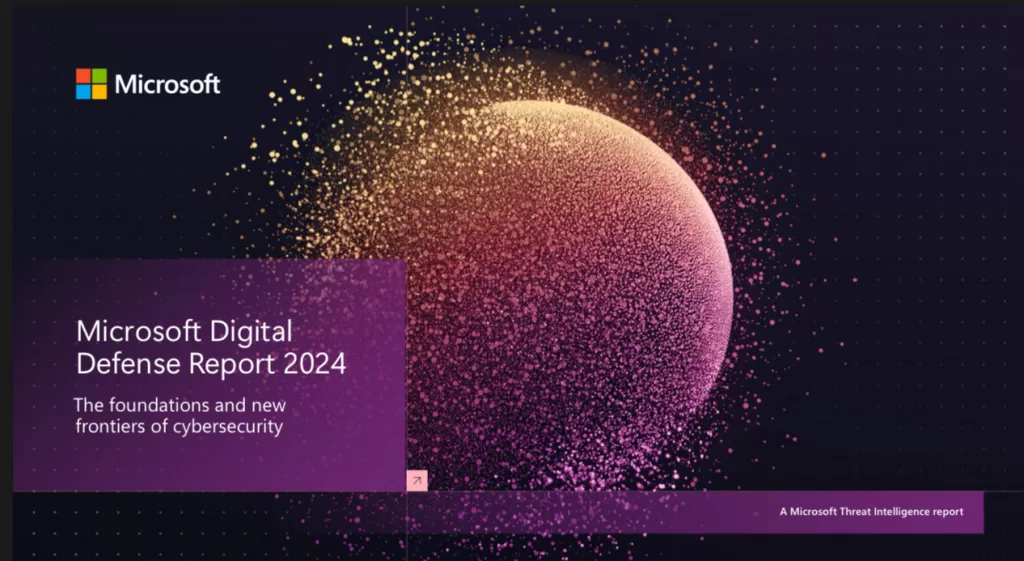The Microsoft Digital Defense Report 2024 paints a vivid and alarming picture of the rapidly evolving cyber threat landscape, where cybercriminals and nation-state actors leverage more sophisticated tools and tactics.
The report highlights the devastating impact of cyberattacks, from ransomware crippling 389 healthcare institutions in the US, leading to delayed medical procedures and risking lives, to nation-state actors like Russia, China, and Iran aggressively interfering in global elections. Perhaps even more striking is North Korea’s cyber-enabled theft of over $3 billion in cryptocurrency, which is believed to be funding more than half of its nuclear and missile programs. These examples underscore the increasingly dangerous digital environment and the need for stronger cyber defenses and international cooperation.
The Microsoft report presents a comprehensive analysis of the escalating complexity of cyber threats and the significant challenges faced by defenders across various sectors. Cyberattacks, whether from nation-state actors or financially motivated cybercriminals, now pose risks to individuals, organizations, and governments on a global scale. Even companies like Microsoft face hundreds of millions of cybercriminal and nation-state attacks daily. The stakes of this battle are incredibly high in critical sectors like healthcare, where cyberattacks have caused widespread disruptions. The report notes that while robust cybersecurity defenses are essential, they alone are not enough. A combination of deterrence mechanisms and government interventions is needed to curb the sheer volume of attacks.
Our takeaway follows: You can get the report and Microsoft’s executive summary here.

The Evolving Cyber Threat Landscape
The report’s first chapter delves into the increasingly blurred lines between cybercriminals and nation-state actors. Nation-state actors, such as those affiliated with Russia, China, North Korea, and Iran, are adopting cybercriminal methods to collect intelligence and disrupt critical infrastructures. This convergence of tactics has created a hybrid threat landscape where financial motivations and geopolitical objectives overlap, leading to more advanced and persistent cyber campaigns, particularly in politically sensitive regions like Ukraine, Israel, and Taiwan. Additionally, the report notes a sharp increase in human-operated ransomware attacks, which disable or tamper with defenses, allowing adversaries to exfiltrate data and launch follow-up attacks. These sophisticated attacks have become particularly dangerous for critical sectors, such as healthcare, where operational disruptions can have life-threatening consequences.
Centering Organizations on Security
The second chapter focuses on building robust cybersecurity foundations within organizations. Microsoft, through its Secure Future Initiative (SFI), has made significant efforts to strengthen its security posture. This company-wide initiative, led by Chief Information Security Officer Igor Tsyganskiy, prioritizes security above all other objectives. In response to recent high-profile attacks by groups like Midnight Blizzard, Microsoft has reassigned over 34,000 engineers to focus on security and implemented phishing-resistant multi-factor authentication (MFA) across its network. These measures have bolstered the company’s ability to defend against both nation-state and cybercriminal threats.
The report also stresses the importance of governance and accountability in cybersecurity. Effective cybersecurity governance requires a holistic approach where all stakeholders, from individual users to executives, understand their role in maintaining security. Collective action is essential for securing digital ecosystems, and Microsoft calls for greater collaboration between private companies and governments to address shared threats.
AI’s Impact on Cybersecurity
In the third chapter, the report shifts its focus to the role of artificial intelligence (AI) in cybersecurity. AI has become a powerful tool for both attackers and defenders. On the one hand, attackers are using AI to scale their operations, automate human targeting, and launch more sophisticated attacks like AI-enabled spear phishing and deepfake influence operations. These AI-driven tactics make social engineering attacks more effective and harder to detect.
On the other hand, AI offers defenders new capabilities. Microsoft is heavily investing in AI-driven security tools that provide defenders with an “asymmetric advantage” over attackers. Microsoft’s Security Operations Center already uses AI-powered systems to automate threat detection and response, cutting the time required to neutralize threats. The report suggests that organizations can leverage AI to develop tailored mitigations for specific cyberattacks, helping them stay ahead of increasingly sophisticated adversaries. However, the report cautions that organizations must adopt AI responsibly to strengthen defenses without introducing new vulnerabilities.
The Role of Governments and International Cooperation
A key theme of the report is the need for stronger government action to deter cyberattacks. While companies like Microsoft can implement technical defenses, government involvement is crucial in enforcing international norms and imposing consequences on bad actors. The report advocates for more robust attributions of cyberattacks, where governments publicly name and shame attackers and impose sanctions or other punitive measures. Additionally, the report highlights the importance of international cooperation in cybersecurity, especially as it pertains to emerging technologies like AI. Governments and industries worldwide must work together to establish standards for AI security to ensure it is used ethically and safely.
Conclusion
The Microsoft Digital Defense Report 2024 paints a sobering yet realistic picture of the current cybersecurity landscape. Defenders are under immense pressure to adapt as cyberattacks continue to rise in scale and sophistication. The report emphasizes the need for a unified approach to cybersecurity that combines strong defenses, cross-sector collaboration, and meaningful deterrence measures. While AI presents challenges and opportunities in cybersecurity, it offers new ways to strengthen defenses and level the playing field against increasingly advanced adversaries. Ultimately, the report calls for a collective effort to secure the digital world, stressing that protecting networks, data, and people must be a top priority for both the public and private sectors.
This evolving threat landscape calls for bold actions to counter increasingly dangerous adversaries, from defending healthcare institutions from ransomware to preventing nation-states from destabilizing democratic processes through cyber-influence campaigns.
Other News: Russian Hackers Breach Microsoft(Opens in a new browser tab).
Other News: North Korean ScarCruft Exploits Windows Zero-Day to Spread RokRAT Malware.